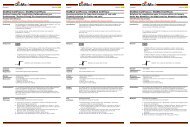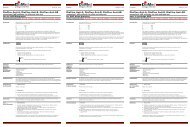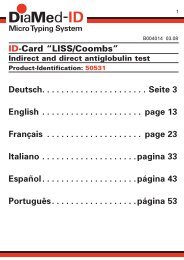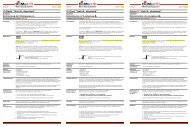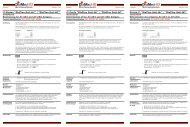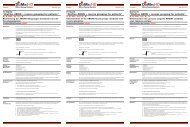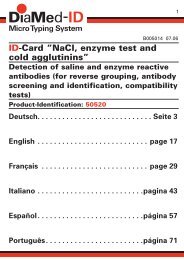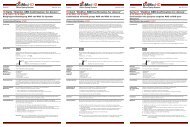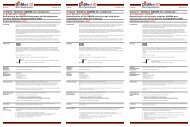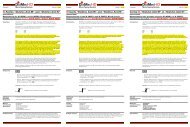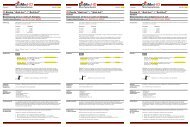Create successful ePaper yourself
Turn your PDF publications into a flip-book with our unique Google optimized e-Paper software.
10<br />
Strictly follow the proposed procedure and apply the following Good Laboratory Practice :<br />
1. Carefully establish the sample distribution and identification plan<br />
2. Prepare the dilute washing solution,<br />
3. Take the carrier tray and the strips (R1) out of the protective pouch,<br />
4. Apply directly, without prior washing of the plate and in succession :<br />
4.1 50 µl of diluent in each well<br />
4.2 150 µl of negative control serum (C0) in well A1- B1 – C1<br />
4.3 150 µl of positive control serum (C1) in wells D1- E1<br />
4.4 150 µl of specimens in wells G1, etc...<br />
Three cell cuture medium controls are necessary instead of the kit Negative Control when testing cell culture<br />
samples. Ensure that the Sample Diluent is well mixed with the specimen (or control).<br />
N.B : The sample distribution can be visually controlled at this step of the manipulation : after adding the sample,<br />
the diluent turns from green to blue to assure that the sample or control has been added to the well. When<br />
properly mixed, the contents of each well are a uniform color. Cell culture samples may not exhibit a color change<br />
depending on which cell culture medium is used. (Refer to section 12 for automatic verification -<br />
SPECTROPHOTOMETRIC VERIFICATION OF SAMPLE PIPETTING).<br />
5. If possible cover the microplate with adhesive film. Press firmly all over the plate to ensure adequate tightness.<br />
6. Incubate the plate for 60 ± 5 minutes at 37 ± 1°C or 40 ± 1°C using a dry-heat static incubator.<br />
7. Remove the adhesive film. Aspirate the contents of all wells into a container for biohazardous waste (containing<br />
sodium hypochlorite). Add into each well a minimum of 0.370 ml of washing solution. Respect a soak time for 20<br />
to 60 seconds. Aspirate again. Repeat this procedure 4 times (i.e. a total of a minimum of 5 washes). The residual<br />
volume must be lower than 10 µl (if necessary, dry the plate by turning it upside down on absorbent paper).<br />
If an automatic washer is used, follow the same procedure (refer to section 10: recommendations)<br />
8. Quickly distribute 100 µl of the Working Conjugate Solution 1 into all wells.<br />
The conjugate must be shaken gently before use.<br />
NB : The distribution of the Working Conjugate Solution 1 which is coloured yellow can be visually controlled<br />
at this step of the manipulation.<br />
9. If possible cover the microplate with adhesive film. Incubate the plate for 30 ± 5 minutes at 37 ± 1°C or<br />
40 ± 1°C using a dry-heat static incubator.<br />
10. Remove the adhesive film. Aspirate the contents of all wells into a container for biohazardous waste (containing<br />
sodium hypochlorite). Add into each well a minimum of 0.370 ml of washing solution. Respect a soak time for 20<br />
to 60 seconds. Aspirate again. Repeat this procedure 4 times (i.e. a total of a minimum of 5 washes). The residual<br />
volume must be lower than 10 µl (if necessary, dry the plate by turning it upside down on absorbent paper).<br />
11. Quickly distribute 100 µl of the Working Conjugate Solution 2 into all wells.<br />
The conjugate must be shaken gently before use.<br />
NB : The distribution of the Working Conjugate Solution 2 which is coloured green can be visually controlled at<br />
this step of the manipulation.<br />
12. If possible cover the microplate with adhesive film. Incubate the plate for 30 ± 5 minutes at 37 ± 1°C or 40<br />
± 1°C using a dry-heat static incubator.<br />
13. Remove the adhesive film, empty all wells by aspiration and wash a minimum of 5 times as described above. The<br />
residual volume must be lower than 10 µl (if necessary, dry the strips by turning them upside down on absorbent<br />
paper.)<br />
14. Quickly dispense into each well 100 µl of prepared development solution (R8+R9), freshly prepared before use.<br />
Allow the reaction to develop in the dark for 30 ± 5 minutes at room temperature (18 - 30°C). Do not use<br />
adhesive film during this incubation.<br />
N.B.: The distribution of the development solution, which is coloured pink, can be visually controlled at this step<br />
of the manipulation : There is a clear difference of colouration between empty well and well containing the pink<br />
substrate solution. (refer to section 12 for automatic verification : SPECTROPHOTOMETRIC VERIFICATION OF<br />
SAMPLE AND REAGENT PIPETTING)<br />
15. Add 100 µl stopping solution (R10) by using the same sequence and rate of distribution as for the substrate<br />
solution. Homogenize the reaction mixture.<br />
N.B.: The distribution of the stopping solution, which is not coloured, can be visually controlled at this step of the<br />
manipulation. After the addition of the stopping solution the pink colouration of the substrate disappears (for the<br />
negative samples) or turns from blue to yellow (for the positive samples).




